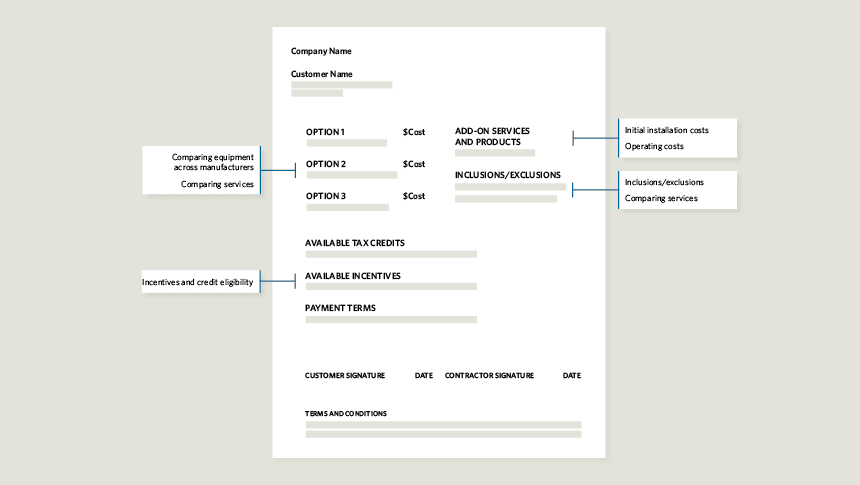A high-efficiency gas fireplace is a great way to bring warmth and ambiance to your home. Let’s look at some factors to consider when shopping for a fireplace and comparing quotes from different installers. By knowing your options and learning how to read and compare a bid, you’ll be well informed to make the right fireplace decision for your home.
How to find your ideal gas fireplace
- You can start picking out your preferred fireplace by visiting a local retailer with a showroom to see the units in person. Once you choose the fireplace you want, the retailer will present one of the following options for installation:
- Provide a list of installers you can contact directly to hire for the installation.
- Sell the unit with an approximate installation price and have either an in-house installer perform the work or go through an external partner who contracts with them.
This option presents a better opportunity to see the broad range of styles and chat with sales staff about the features unique to each model. The drawback is that the dimensions and characteristics of the installation location are not clear and will likely require a visit by the installer to provide a firm installation price. Having the installer visit your home will help you focus your final choice and determine pricing.
- You can look up gas fireplace installers in your area and have them come to your home to present a range of fireplace options best suited to your needs. Together, you’ll look through product brochures, physical material samples and manufacturer websites to review possible options. Their proposal will include the price of the unit as well as the installation. This option works well for a customer who knows generally what they want and doesn’t have a local retail shop to see the options in person.
- You can also purchase a fireplace online and then contact local installers to provide a quote for the installation. There are some risks to this option to be aware of: You may find that some contractors will not install equipment that you bought through an online vendor. Also, you may have a difficult time returning the fireplace if there are issues with how it fits into the intended location. You may find the online store has a customer support line to assist you in choosing the correct fireplace option for your home. It is recommended you work with a professional before purchasing your fireplace.
Whichever path you take to finding your gas fireplace and installer, reading and comparing bids for services can be a challenge. Consider the following to help guide you through this process.
Sample bid:

Reviewing contractor bids
When it’s time to choose an installer for your fireplace project, there are a number of key items to look at while comparing bids.
Inclusions/exclusions
Inclusions are what the contractor is committing to complete for the quoted amount. Exclusions typically describe work related to the primary services that the contractor wants to clarify are not included in the price. This may include removing or recycling existing equipment, electrical services, gas line installation, chimney repair, etc. It’s important to ask your contractor if they believe you’ll need any of these services to complete the project. While contractors may clearly call out services or products not included, it’s also safe to assume that if it’s not mentioned at all, it probably means it’s not included. It’s your responsibility to have the services you expect in writing before signing the bid. This includes expectations around site cleanup at the end of the day/project, permit costs, warranty coverage (labor vs. parts) and rebate/incentive support. If you see something called out on Contractor A’s bid, but not included with Contractor B, this is a good opportunity to ask why.
Comparing equipment across manufacturers
As you compare bids from various contractors and/or retail shops, you will likely find yourself choosing between a variety of fireplace brands. Beyond referring to third-party, consumer report-style websites, you can look for other distinguishing factors to assist in your decision process:
- Length of warranty: Look for warranty length as well as labor (the cost of having a contractor perform a repair) vs. parts (the cost of physical components being replaced). Some warranties will also limit coverage to specific components. Understanding what is and is not included in the warranty for each product, as well as the associated duration of coverage, will help in your process of ranking the options.
- Price vs. value: Some brands offer more bells and whistles but that typically comes at a cost. Some examples of these upgrades include reduced noise during operation, enhanced temperature controls, built-in lighting and a backup battery for the igniter. Don’t hesitate to ask the contractor what those features will mean specifically for you and your home and decide if the value is equivalent to the cost.
- Efficiency ratings: Gas fireplace efficiency is rated by FE (Fireplace Efficiency), which is a performance rating measuring the percentage of gas converted to heat delivered into the home. The higher the FE rating, the less gas is wasted during the combustion process. Higher performance ratings generally lead to incrementally better performance of the system. This can be a valuable distinguishing factor when comparing brand models.
- Incentives and credit eligibility: Your bid will likely include the amount of Energy Trust incentives and other credits available for each proposed system. If you don’t see any mention of incentives, double check with the retailer or contractor before comparing total costs between each of the bids. Be sure to have any promised credits listed out in writing before signing the bid.
Initial install costs
Installation costs can vary significantly, both by contractor and across different conditions of the installation location. As referenced in the section above, be sure to thoroughly review the estimates provided by the contractors bidding on your project and compare what is and is not in the description of services.
Operating costs
The costs associated with a gas fireplace are not limited to the initial installation costs. The amount of money spent to run the gas fireplace, better known as the “operating cost,” is just as important. While there isn’t a way to predict the exact cost of operating your new gas fireplace, here are six key factors that influence this cost:
- Choosing the correct size: The amount of heat produced by a gas fireplace is measured by “BTUs” (British Thermal Units). Ask your contractor or fireplace retailer to help you choose the right size of fireplace based on the volume of the space you want to heat, location of the home and how well sealed and insulated your home is. An undersized system will run continuously and may never fully heat the space. An oversized system will cycle on and off, reducing efficiency and putting unnecessary wear and tear on the system.
- System installation: The quality of your installation can have a big impact on the performance of your system as well as overall safety. Make sure your installer has all of the information provided by the manufacturer if you did not purchase it directly through the installer.
- Thermal and air leakage of a home: Your home’s ability to retain the heat produced by a gas fireplace should be considered before installation. Energy Trust recommends you check for drafts or air leaks and consider upgrading your insulation levels if they are below today’s standards. Check out our article on insulation options and the ENERGY STAR® guide to sealing and insulating for additional resources.
- Routine maintenance: We recommend that you have a certified technician service your fireplace annually to clean and adjust the burner to maximize the performance.
- Electric ignition vs. standing pilot light: A gas fireplace using an electric ignition to produce the flames, instead of a standing pilot light, eliminates the need to have a small but steady stream of gas fueling a flame when the unit is not in operation.
- System performance rating(s): If it isn’t clearly stated on the product display or brochure, you can request the FE (Fireplace Efficiency) rating of your unit from your retailer or installer. The higher the rating, the less energy the system is designed to use.
Don’t miss out on the incentives and benefits available to you when upgrading to an energy-efficient gas fireplace. Energy Trust incentives could save you up to $250 on qualifying gas fireplaces. You’ll also enjoy the long-term benefits of energy savings and enhanced home comfort.
Fireplace savings
Find incentives for high-efficiency gas fireplaces



